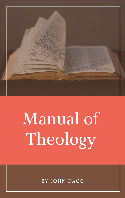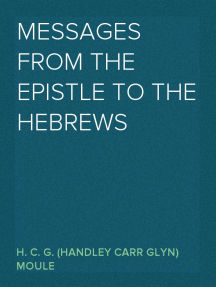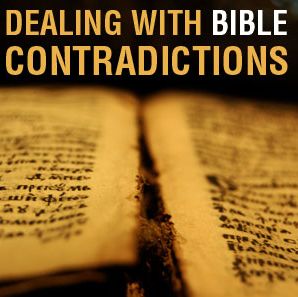Gaebelein Acts of the Apostles
Gaebelein Acts of the Apostles In this 30 chapter commentary on Acts, Gaebelin (Brethren) has a chapter for each of the chapters of Acts.
THE ACTS OF THE APOSTLES
An Exposition
by Arno C. Gaebelein
Copyright © 1912

Dagg Manual of Theology (and links to this work in various other formats).
Dagg Manual of Theology (MySword for Android)
Dagg Manual of Theology (theWord Bible Format)
Dagg Manual of Theology (esword format)
Dagg Manual of Theology (PDF Format)
edited for 3BSB by Baptist Bible Believer in the spirit of the Colportage Ministry of a century ago
http://www.baptistbiblebelievers.com/
~ out-of-print and in the public domain ~
This book was originally published prior to 1923, it is therefore in the public domain and free to be posted in its entirety despite recent publication.
Please note: If you wish to read (which is absolutely free), simply click on the chapter title. You will have the option to either open it or to save it to your computer. To create a folder, right click and choose new – Folder, and name it the title of the book.
GOD bless you from the Baptist Bible Believers website!
Please tell everyone you know about this website, pray for this ministry – and that will be payment enough!
“Buy the truth, and sell it not; also wisdom, and instruction, and understanding” (Pro 23:23)
TABLE OF CONTENTS
Foreward
Introduction
1. Chapter One
2. Chapter Two
3. Chapter Three
4. Chapter Four
5. Chapter Five
6. Chapter Six
7. Chapter Seven
8. Chapter Eight
9. Chapter Nine
10. Chapter Ten
11. Chapter Eleven
12. Chapter Twelve
13. Chapter Thirteen
14. Chapter Fourteen
15. Chapter Fifteen
16. Chapter Sixteen
17. Chapter Seventeen
18. Chapter Eighteen
19. Chapter Nineteen
20. Chapter Twenty
21. Chapter Twenty-One
22. Chapter Twenty-Two
23. Chapter Twenty-Three
24. Chapter Twenty-Four
25. Chapter Twenty-Five
26. Chapter Twenty-Six
27. Chapter Twenty-Seven
28. Chapter Twenty-Eight
FOREWORD
Judaism and Christianity; Legalism and Grace; the Kingdom and the Church; these are in contrast, at poles apart, and defy all attempts at reconciliation. Ishmael – “the wild-ass man” – untamed and untamable, the son of the bond woman, is unalterably opposed to Isaac – “laughter” – spontaneous and obedient, the son of the free woman.
These distinctions, known and observed, are of incalculable worth in Bible Study.
In The Book of the Acts there is revealed the passing of Judaism, and the incoming of Christianity: wherein we see how the old wine-skins of legalism are without strength to restrain the expansive spirit of the new wine of grace. This Book of the Acts, showing as it does the transition of Judaism to Christianity, is, therefore, of absorbing interest; and Mr. Gaebelein, whose oral teaching is so abundantly owned and blessed of GOD, has, in this volume of interpretative study, extended the sphere of his ministry to multitudes that may never come within range of the hearing of his voice.
The author’s breadth of conception of GOD’s plan of the Ages stamps the book with a peculiar value; while, at the same time, there is of the spiritual application of truth a thorough and clear perception that pervades and illumines the exposition of the text.
From the study of this book, so untrammeled by the yoke of traditional interpretation, so far removed from the feverish discontent with the supernatural, so different from the cold and critical analysis of the casuist, so reverent. and so unalterably loyal to the plenary inspiration of the Scripture, one rises in spirit refreshed, in faith strengthened and to new endeavor encouraged. It is a pleasure and a privilege to commend this book.
Ford C. Ottman
Stamford. Conn.
INTRODUCTION
The book known by the name “The Acts of the Apostles” [*] follows the four Gospel records. This is its proper place.
[*] “‘The oldest Manuscript, the Sinaiticus dating from the 4th century gives the title simply as “The Acts.”
The books of the New Testament have been correctly divided into five sections, corresponding to the first five books, with which the Bible begins, that is the Pentateuch.
The four Gospels are the Genesis of the New Testament. Here we have the great beginning, the foundation upon which the subsequently revealed Christian doctrines rest.
The Book of Acts is the Exodus, GOD leads out from bondage a heavenly people and delivers them. It is the great historical book of the New Testament describing the beginning of the church on earth.
The Pauline Epistles are the Leviticus portion. Holiness unto the Lord, the believers separation and standing in CHRIST, what believers have and are in CHRIST by whose blood they have redemption, is the core truth of these Epistles.
The Epistles of Peter, James, John and Jude, known by the name of the Catholic Epistles, are for the wilderness journey of GOD’s people, telling us of trials and suffering; these correspond to the Book of Numbers.
The Book of Revelation in which GOD’s ways are rehearsed and a review is given of the entire prophetic Word concerning the Jews, the Gentiles and the Church of GOD has the same character as Deuteronomy.
By whom was this Book written?
There is no doubt that the writer of the third Gospel record is the one whom the Holy Spirit selected to write this account of the establishment of the Church on earth and the events connected with it. This becomes clear if we read the beginning of that Gospel and compare it with the beginning of Acts. The writer in the third Gospel says: “It seemed good to me also, having had perfect understanding of all things from the first, to write unto thee in order, most excellent Theophilus, that thou mightest know the certainty of those things, wherein thou hast been instructed” (Luk 1:3-4).
The Acts of the Apostles begin: “The former treatise have I made, O Theophilus, of all that Jesus began both to do and teach.”
The former treatise known to Theophilus is the third Gospel, called the Gospel of Luke. The writer of that Gospel is also the penman of the Book of Acts. Though we do not find Luke’s name mentioned in the Gospel nor in the second Book he was entrusted to write, there is no doubt that he wrote them both.
We find his name mentioned a number of times in the Epistles and these references give us the only reliable information we have.
– In Col 4:14 we read of him as “the beloved physician.”
– In the Epistle of Philemon he is called a fellow laborer of the Apostle Paul, and
– from the last Epistle the great Apostle wrote, the Second Epistle of Timothy, we learn that Luke was in Rome with
Paul and was faithful to him, while others had forsaken the prisoner of the Lord.
From Colossians 4 we also may gather that he was not a Jew, but a Gentile, for with the eleventh verse Paul had mentioned those of the circumcision. Epaphras was one of the Colossians, a Gentile, and then follow the names of Luke and Demas, both of them undoubtedly Gentiles.
The reason that the Holy Spirit selected a Gentile to write the Gospel which pictures our Lord as the Man and the Saviour and the Book of Acts, is as obvious as it is interesting. Israel had rejected GOD’s gift and the glad news of salvation is now to go to the Gentiles. The Gospel of Luke addressed by a Gentile to a Gentile (Theophilus) is the Gospel for the Gentiles and Luke the Gentile was chosen to give the history of the Gospel going forth from Jerusalem to the Gentiles.
There are numerous internal evidences which show likewise that the writer of the third Gospel is the instrument through whom the Book of Acts was given. For instance, there are about fifty peculiar phrases and words in both books which are rarely found elsewhere; they prove the same author for those two books.
Then we learn from the Book of Acts that Luke, the beloved physician, was an eyewitness of some of the events recorded by him in this book.
He joined the Apostle during his second missionary journey at Troas (Act 14:10). This evidence is found in the little word “we.”
The writer was now in company of the Apostle, whose fellow laborer he was. He went with Paul to Macedonia and remained sometime in Philippi. He was Paul’s fellow traveler to Asia and Jerusalem (Act 21:17). He likewise was with him in his imprisonment in Caesarea and then on to Rome. There is no doubt that Luke had completely written and sent forth the Book of the Acts of the Apostles at the end of the two years mentioned in Act 28:30, though the critics claim a much later period.
The contents and scope of the Book.
The first verse gives us an important hint. The former treatise, the Gospel of Luke, tells “that Jesus began to do and teach.” The Book of Acts contains therefore the continuation of the Lord’s actions no longer on earth but from the Glory.
The actions of the risen and glorified CHRIST can easily be traced throughout the entire book.
We give a few illustrations.
– In Chapter 1 He acts in the selection of the twelfth Apostle, who was to take the place of Judas.
– In Chapter 2 He himself poured forth the Holy Spirit, for Peter made the declaration: “therefore, being by the right hand of God exalted, and having received of the Father the promise of the Holy Spirit, He has poured out this which ye behold and hear.”
– And in the close of the second chapter we behold another action of the risen Lord: “the Lord added to the church daily those that were to be saved.”
– In the third chapter He manifested His power in the healing of the lame man.
– Throughout this book we behold Him acting from the Glory, guiding, directing, comforting and encouraging His servants.
These beautiful and manifold evidences of Himself being with His own and manifesting His power in their behalf we hope to trace in our exposition of the different chapters.
Then on the very threshold of the book we have the historical account of the coming of that other Comforter, whom the Lord had promised, the Holy Spirit.
On the day of Pentecost the third Person of the Trinity, the Holy Spirit, came. His coming marks the empowerment of the Church. After that event we see Him present with and in His people.
In connection with the Lord’s servants, in filling them, guiding them, fitting them, sustaining them in trials and persecutions as well as in the affairs of the church, we behold the actions of the Holy Spirit on earth. He is the great administrator in the church. Over fifty times we find Him mentioned, so that some have called this book “the Acts of the Holy Spirit.” While we have no doctrines about the Holy Spirit and His work in the Acts of the Apostles, we find here the practical illustrations of the doctrine found elsewhere in the New Testament.
In the third place another supernatural Being is seen acting in this book. It is the enemy, Satan, the hinderer and the accuser of the brethren.
We behold him coming upon the scene and acting through his different instruments either as the roaring lion or as the cunning deceiver with his wiles. Wherever he can, he attempts to hinder the progress of the Gospel. This is a most important aspect of this book and indeed very instructive. Aside from the human instruments prominent in this Book of Acts, we behold three supernatural Beings acting. The risen, glorified CHRIST, the Holy Spirit and Satan.
Another hint about the contents of this book and its scope we find at the close of the Gospel of Luke. There the risen CHRIST said: “that repentance and remission of sins should be preached in His Name to all the nations beginning at Jerusalem.”
In the first chapter of Acts the Spirit of GOD reports the commission of the Lord, about to ascend, in full.”Ye shall be my witnesses both in Jerusalem and in all Judea and Samaria, and to the end of the earth.”
The Book of Acts shows us how this mission beginning in Jerusalem was carried out.
The witness begins in the city where our Lord was crucified. Once more an offer was made to the nation Israel. Then we behold the Gospel going forth from Jerusalem and all Judea to Samaria and after that to the Gentiles, and through the chosen Apostle of the Gentiles it is heralded in the different countries of the Roman empire.
The parable of our Lord in Mat 22:1-10 gives us prophetically the history of these events.
– First the guests were called to the wedding and they would not come. This was the invitation given by the Lord to
His earthly people when He moved among them. They received Him not.
– Then came a renewed offer with the assurance that all things are ready. This is exactly what we find in the beginning of the Book of Acts. Once more to Jerusalem and to the Jewish nation is offered the kingdom, and signs and miracles take place to show that Jesus is the CHRIST risen from the dead.
In the above parable our Lord predicted what the people would do with the servants, who bring the second offer.
They would ignore the message and treat the servants spitefully and kill them. This we find fulfilled in the persecution which broke out in Jerusalem, when Apostles were imprisoned and others were killed.
The Lord also predicted in His parable the fate of the wicked city. It was to be burned. Thus it happened with Jerusalem. And after the second offer had been rejected the servants were to go to the highways to invite the guests.
And this stands for the invitation to go out to the Gentiles.
Jerusalem is in the foreground of this book, for the beginning was to be in Jerusalem “to the Jew first.” The end of the book takes us to Rome and we see the great Apostle a prisoner there, a most significant, prophetic circumstance.
The division of the Book.
The division of the Book of the Acts is very simple. We divide it into three parts.
I. Chapters 1-7. These chapters give us the historical account of the beginning in Jerusalem, the renewed testimony to the nation concerning Jesus as the CHRIST and the Kingdom. The seventh chapter, the stoning of Stephen, closes that testimony.
II. Chapters 8-12. These chapters mark a transition period. The Gospel goes forth to Samaria. Saul of Tarsus sees the Lord and is converted. Peter goes and preaches the Gospel to the Gentiles. Peter is cast into prison and miraculously delivered.
In these two parts Peter is in the foreground. He does most of the preaching and acting. He used the Keys of the Kingdom of Heaven in the second chapter by preaching to the Jews and in the tenth chapter by preaching to the Gentiles.
III. Chapters 13-18. These chapters contain the inspired accounts of the travels and labors of the Apostle Paul, the proclamation of the Gospel in the different lands and the events and circum-stances connected with it. His journey to Rome and abode there closes the book.
Another division as given by Bengel in his Gnomen is also good.
I. Pentecost, with preceding events. Ch. 1, 2.
II. Acts in Jerusalem, and in all Judea and in Samaria among the circumcised. Ch. 3-9, 12.
III. Acts in Caesarea and admission of Gentiles. Ch. 10, 11.
IV. First Journey among the Gentiles. Ch. 13, 14.
V. The deputation and council in Jerusalem. Ch. 15.
VI. Second Journey of Paul. 16-19.
VII. Journey to Jerusalem and Rome. 19:21-28:31.
In closing these brief introductory remarks to this great book we wish to say that the careful study of its contents is very needful at the present time. It will take us back to the beginning and show us the path which the Lord has marked out for His church on earth. In the light of this book we shall discover the dark picture of the present day confusion and departure from GOD and from His Word. There is much comfort and direction for the faithful remnant of GOD’s people living in our days in this book. There is much earnest exhortation to greater faithfulness, to more holy boldness in preaching the Gospel and standing up for the faith, which comes to us from this book. Most blessed it is to follow the Holy Spirit in His work in, upon and with the believer. With the gracious help of our Lord and the help of His Spirit we hope to touch upon all these blessed phases, and we are confident that He will make the closer study of the Acts of the Apostles a blessing to our readers as well as to the writer.
~ end of Introduction ~
Download
Download “gaebelein-a-c-the-acts-of-the-apostlesfuz.gbk.twm” gaebelein-a-c-the-acts-of-the-apostlesfuz.gbk.twm – Downloaded 168 times – 3.31 MBMore Commentaries on Acts
- Allen Commentary on Acts
- Copeland, M. – Acts Conversions
- Expositor’s Bible Vol 34 The Acts of the Apostles Vol I and II by G.T. Stokes.cmt
- Fortner Discovering Christ in Acts
- Gaebelein Acts of the Apostles
- McGarvey – Four Fold Gospel and Acts (FFG)
- Morgan Commentary on 3 Gospels, Acts, and Romans
- Spurgeon Sermon Commentary from Acts thru Revelation
Advertisement
In the classtheWord Bible Bookmarks we review how to open and close the Bible bookmarks bar, and how to use it.

